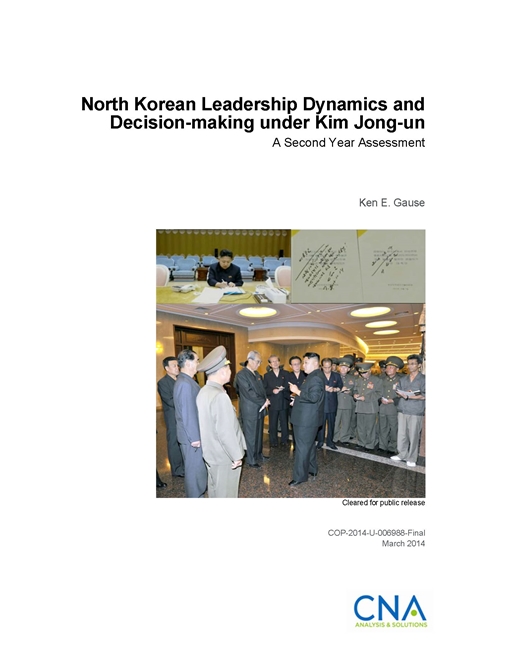North Korean Leadership Dynamics and Decision-making under Kim Jong-un
Kim Jong-il’s death in December 2011 brought about the hereditary transition of power to a third generation. Kim Jong-un, Kim Jong-il’s youngest son, assumed the mantle of Supreme Leader. In a little over a year, he had acquired all of the titles of power, including Supreme Commander, First Secretary of the Korean Workers’ Party, and First Chairman of the National Defense Commission. In December 2013, Kim Jong-un violently purged his uncle, Jang Song-taek, in a move that seemingly has accelerated his power consolidation process. He is 30 (or 31) years old. This paper is an update of an earlier CNA monograph published in September 2013 that examined the leadership and decision-making dynamics under Kim Jong-un. The author felt that Jang Song-taek’s purge and the ramifications it has for the North Korean political structure are so profound that an update was warranted.
The September 2013 monograph argued that Kim Jong-un, while the ultimate decision-maker and sole source of legitimacy for the regime, had yet to fully consolidate his power. While he may have been invested with inherent legitimacy by virtue of his position as Supreme Leader, he still needed to grow into the position and learn how to effectively wield power. This was a process of demonstrating capability and relationship building that could take one to two more years. In fact, Kim Jong-un, the paper argued, was currently involved in a three-phase process of consolidation.
The first phase, which began shortly after he was formally designated the heir apparent (September 2010) and was drawing to a close in the fall of 2013, focused on the stabilization of the three-generation hereditary succession. In this period, potential opposition to the hereditary transition of power had been stamped out through purges and retirements.
The second phase, which began in earnest in 2013, was focused on Kim’s steps to establish a power base, which would owe its loyalty directly to him. This patronage system would likely be tied to moves to accommodate the twin regime policy philosophies of “Military First” and “Creating a Strong and Powerful Nation.” It was likely that as this phase played out and Kim Jong-un began to exert his independence as a decision-maker, the current regent/advisory structure would begin to change— something that could lead to churn within the upper reaches of the leadership.
The final phase, according to many Pyongyang watchers, would begin around 2015, when Kim Jong-un would be able to assume the full responsibilities of his position as Supreme Leader. He would have established his own decision-making processes and would be more directly responsible for policy formulation and execution. He would most likely begin to marginalize his regents, which could intensify the opposition exhibited in phase 2.
If Kim Jong-un could survive this final period with his position intact, the paper argued, regime stability would probably be ensured for the foreseeable future. But, there was a possibility that his powers could be curbed or that he would become a puppet to powerful forces inside the regime. If this should occur, the stability of the regime could come into question.
The move against Jang, the reasons for which are unclear as of this writing (January 2014), has accelerated this timeline. Instead of entering the second phase, as was argued in the previous edition of this paper, Kim Jong-un has quickly moved to the final phase of power consolidation. The regent structure that was placed around him by Kim Jong-il has nearly evaporated, and the remaining regents are more accurately described as senior advisors.
Download reportCleared for public release, distribution unlimited.
Details
- Pages: 206
- Document Number: COP-2014-U-006988-Final
- Publication Date: 3/10/2014
